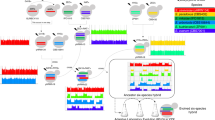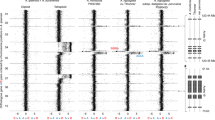Abstract
Conger and Johnston1 have concluded, from studies of the effects of X-radiation in a flower bud of Tradescantia paludosa containing a mixed population of diploid and haploid microspores, that chromosomal radiosensitivity or sensitivity per unit length of chromosome is identical in haploid and diploid cells. The results of different workers in which radiation sensitivity of cells of polyploid plants has been found to be equal to, greater or less than comparable diploids have been attributed by them to intrinsic differences in species sensitivity rather than to the effect of polyploidy itself. In a comparative study of the frequency of chromosome aberrations induced by different types of radiations on diploid, tetraploid and hexaploid Triticum species, we observed that the results obtained varied with the type of radiation used.
This is a preview of subscription content, access via your institution
Access options
Subscribe to this journal
Receive 51 print issues and online access
$199.00 per year
only $3.90 per issue
Buy this article
- Purchase on Springer Link
- Instant access to full article PDF
Prices may be subject to local taxes which are calculated during checkout
Similar content being viewed by others
References
Conger, A. D., and Johnston, A. H., Nature, 178, 271 (1956).
Konzak, C. F., and Singleton, W. R., Genetics, 37, 596 (1952).
Author information
Authors and Affiliations
Rights and permissions
About this article
Cite this article
SWAMINATHAN, M., NATARAJAN, A. Polyploidy and Radiosensitivity. Nature 179, 479–480 (1957). https://doi.org/10.1038/179479a0
Issue Date:
DOI: https://doi.org/10.1038/179479a0
This article is cited by
-
Chromosome weights and measures in the Triticinae
Heredity (1970)
-
Polyploidy and radiosensitivity in wheat and barley
Genetica (1962)
-
Polyploidy and radiosensitivity in wheat and barley
Genetica (1962)
-
Chromosome diminution and evolution of polyploid species in triticum
Chromosoma (1961)
Comments
By submitting a comment you agree to abide by our Terms and Community Guidelines. If you find something abusive or that does not comply with our terms or guidelines please flag it as inappropriate.



